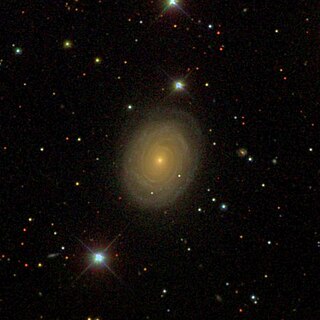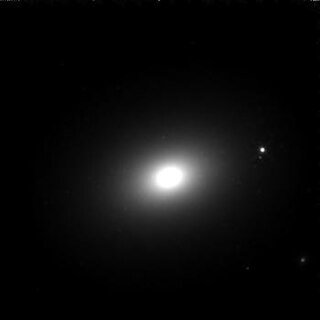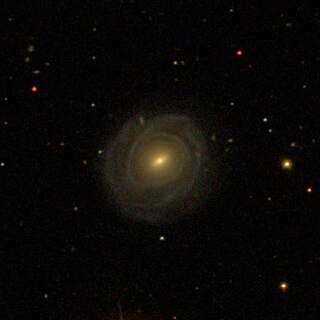
NGC 4536 is an intermediate spiral galaxy in the constellation Virgo located about 10° south of the midpoint of the Virgo cluster. However, it is not considered a member of the cluster. Rather, it is a member of the M61 Group of galaxies, which is a member of the Virgo II Groups, a series of galaxies and galaxy clusters strung out from the southern edge of the Virgo Supercluster. The morphological classification in the De Vaucouleurs system is SAB(rs)bc, which indicates it is a weakly barred spiral galaxy with a hint of an inner ring structure plus moderate to loosely wound arms. It does not have a classical bulge around the nucleus.

NGC 4639 is a barred spiral galaxy located in the equatorial constellation of Virgo. It was discovered by German-born astronomer William Herschel on April 12, 1784. John L. E. Dreyer described it as "pretty bright, small, extended, mottled but not resolved, 12th magnitude star 1 arcmin to southeast". This is a relatively nearby galaxy, lying approximately 72 million light-years away from the Milky Way. It is a companion to NGC 4654, and the two appear to have interacted roughly 500 million years ago. NGC 4639 is a member of the Virgo Cluster.
An extragalactic planet, also known as an extragalactic exoplanet or an extroplanet, is a star-bound planet or rogue planet located outside of the Milky Way Galaxy. Due to the immense distances to such worlds, they would be very hard to detect directly. However, indirect evidence suggests that such planets exist. Nonetheless, the most distant known planets are SWEEPS-11 and SWEEPS-04, located in Sagittarius, approximately 27,710 light-years from the Sun, while the Milky Way is about 87,400 light-years in diameter. This means that even galactic planets located further than that distance have not been detected.

NGC 4388 is an active spiral galaxy in the equatorial constellation of Virgo. It was discovered April 17, 1784 by Wilhelm Herschel. This galaxy is located at a distance of 57 million light years and is receding with a radial velocity of 2,524km/s. It is one of the brightest galaxies of the Virgo Cluster due to its luminous nucleus. NGC 4388 is located 1.3° to the west of the cluster center, which translates to a projected distance of ≈400 kpc.

NGC 2768 is a lenticular galaxy located in the constellation of Ursa Major. It is at a distance of 65 million light years from Earth. NGC 2768 is an example of a Seyfert galaxy, an object with a supermassive black hole at its centre. A dusty structure is encircling the centre of the galaxy, forming a knotted ring around the galaxy's brightly glowing middle. This ring lies perpendicular to the plane of NGC 2768 itself, stretching up and out of the galaxy. The dust in NGC 2768 forms an intricate network of knots and filaments.

NGC 7001 is an intermediate spiral galaxy located about 300 million light-years away in the constellation Aquarius. NGC 7001 has an estimated diameter of 123,000 light-years. It was discovered by English astronomer John Herschel on July 21, 1827, and was also observed by Austrian astronomer Rudolf Spitaler on September 26, 1891.

NGC 7002 is a large elliptical galaxy, and a radio galaxy, around 320 million light-years away from Earth in the constellation of Indus. The galaxy was discovered by English astronomer John Herschel on September 30, 1834. NGC 7002 is the brightest member of a group of galaxies known as [T2015] nest 200093. The group contains 12 member galaxies including NGC 7004, has a velocity dispersion of 440 km/s and an estimated mass of 1.28 × 1014M☉. NGC 7002 is also host to a supermassive black hole with an estimated mass of 2.7 × 109M☉.

NGC 7014 is an elliptical galaxy located about 210 million light-years away from Earth in the constellation Indus. NGC 7014 was discovered by English astronomer John Herschel on October 2, 1834. A population of around 1,634 known globular clusters surround the galaxy, and it is also host to a supermassive black hole with an estimated mass of 2.6 × 109M☉. NGC 7014 is also classified as a type 1 seyfert galaxy.

NGC 4473 is an elliptical galaxy located about 50 million light-years away in the constellation of Coma Berenices. It was discovered by astronomer William Herschel on April 8, 1784. NGC 4473 has an inclination of about 71°. NGC 4473 is a member of a chain of galaxies called Markarian's Chain which is part of the larger Virgo Cluster of galaxies.

In astronomy, a disrupted planet is a planet or exoplanet or, perhaps on a somewhat smaller scale, a planetary-mass object, planetesimal, moon, exomoon or asteroid that has been disrupted or destroyed by a nearby or passing astronomical body or object such as a star. Necroplanetology is the related study of such a process.

NGC 4564 is an elliptical galaxy located about 57 million light-years away in the constellation Virgo. NGC 4564 was discovered by astronomer William Herschel on March 15, 1784. The galaxy is also a member of the Virgo Cluster.

NGC 4596 is a barred lenticular galaxy located about 55 million light-years away in the constellation Virgo. NGC 4596 was discovered by astronomer William Herschel on March 15, 1784. NGC 4596 is a member of the Virgo Cluster and has an inclination of about 38°.

NGC 4660 is an elliptical galaxy located about 63 million light-years away in the constellation Virgo. The galaxy was discovered by astronomer William Herschel on March 15, 1784 and is a member of the Virgo Cluster.

NGC 4939 is a spiral galaxy located in the constellation Virgo. It is located at a distance of about 120 million light years from Earth, which, given its apparent dimensions, means that NGC 4939 is about 190,000 light years across. It was discovered by William Herschel on March 25, 1786.

NGC 3640 is an elliptical galaxy located in the constellation Leo. It is located at a distance of circa 75 million light years from Earth, which, given its apparent dimensions, means that NGC 3640 is about 90,000 light years across. It was discovered by William Herschel on February 23, 1784. It is a member of the NGC 3640 Group of galaxies, which is a member of the Leo II Groups, a series of galaxies and galaxy clusters strung out from the right edge of the Virgo Supercluster.

NGC 4294 is a barred spiral galaxy with flocculent spiral arms located about 55 million light-years away in the constellation Virgo. The galaxy was discovered by astronomer William Herschel on March 15, 1784 and is a member of the Virgo Cluster.

NGC 4318 is a small lenticular galaxy located about 72 million light-years away in the constellation Virgo. It was discovered by astronomer John Herschel on January 18, 1828. NGC 4318 is a member of the Virgo W′ group, a group of galaxies in the background of the Virgo Cluster that is centered on the giant elliptical galaxy NGC 4365.
A blanet is a member of a hypothetical class of exoplanets that directly orbit black holes.

NGC 4326 is a barred spiral galaxy with a ring located about 330 million light-years away in the constellation Virgo. It was discovered by astronomer William Herschel on April 13, 1784, who described it as "vF, S, R, bM, 1st of 3". It is a large galaxy, with a diameter of around 200,000 ly (61 kpc) making it nearly twice the size of the Milky Way. NGC 4326 is also classified as a LINER galaxy. Despite being listed in the Virgo Cluster catalog as VCC 623, it is not a member of the Virgo Cluster but instead a background galaxy.



















